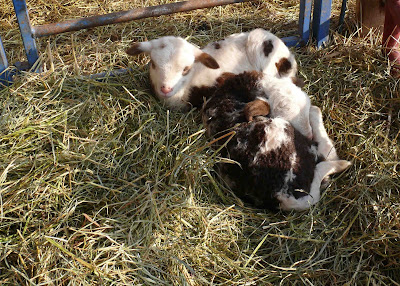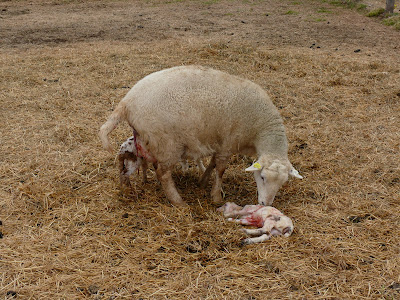Well, after last week's kidding by Lucy, we have finally concluded our first (and last! lol) February lambing.

Granted, who could have predicted the worst weather in recorded history and all in all, we did pretty well despite the weather. This was our first try at winter lambing and it was not completely satisfactory.
The advantages of lambing on pasture, our normal practice, were clear pretty quickly. Aside from the obvious issues about cold weather, we kind of overlooked the difficulties of keeping a clean environment with so many animals on the barnyard.
Without good hygiene, enterocolitis and coccidia become major problems and treatment can be difficult, time-consuming, and somewhat unsatisfactory.
Here are some of our bottle babies during feeding time. We took a more aggressive stance and culled several mom's with non-functioning teats and other irreparable problems.
Lambing on pasture allows you to take advantage of the natural cleaning properties of wind, sun and rain. The mother's segregate themselves to find a quiet corner to lamb in.
Given the fact that katahdins are such good mothers and easy lambing predominates, assisted deliveries are rare. the biggest problem we've had is new mom's confusing lambs born at about the same time and highly hormonal expectant mom's stealing other's lambs! lol

We lost 2 lambs to cold and one lamb to a pneumonia, but the remaining 125 are doing beautifully!
We also had 4 malpresentations, one retained lamb, 4 mummies, 4 cases mastitis, one set of quads, one set of septuplets, and one emergency c-section.
I'm not entirely sure but believe that our c-section dame may have ruptured her uterus plus or minus a placenta previa. Her two lambs are doing fine on the bottle and I expect to retain both for our genetics.

Here's a sequence that illustrates nicely the normal progression of lambing:

This ewe has already delivered her first lamb when I arrived. Note the fresh umbilical cord hanging below her lamb.

The dame continues to paw the ground in a nesting maneuvers while she smells and explores her lamb, cleaning it quickly by licking it dry. This cleans up the scents of blood that might draw a predator and dries the lamb who can chill very quickly.
The lamb will quickly struggle to its feet and start searching for the teat. It is vital that it find the teat quickly in order to get as much colostrum as possible.
Colostrum is like lamb jet fuel, very high in calories, fat and energy, as well as vital antibodies to shore up the lambs non-existant immune system. Without colostrum, the lamb is MUCH more likely to perish from cold, pneumonia and starvation.


The lamb has found the teat and her nursing action stimulates prolactin release in the brain which encourages milk let-down and stimulates more uterine contractions. Suddenly the ewe is back in labor and is gearing up for her next lamb.




The ewe lays down, pushes out another lamb and then quickly gets up, turns and starts cleaning and stimulating her second lamb. If this happens too quickly after her first lamb is born, one lamb may not get the attention it needs.
Sometimes, the amniotic sac is covering the new lamb's airway and without mom's help, the young lamb may not be able to break free on its own.




With the second lamb nursing, mom's contractions are really kicking in and she quickly has the urge to push once again. The process repeats itself for a third time and she is done. The afterbirth will follow within a few hours and the best mother's eat the placenta to clean the birth site and as a valuable nutritional addition. Her body condition will deteriorate rapidly over the next 10 weeks as she nurses 3 lambs and she needs every calorie, all the iron and protein she can get.
~K


WOWZA! Triplets! What a great ewe!
ReplyDeleteGreat photos too!
Will look for you in Bethesda. I miss your great eggs.